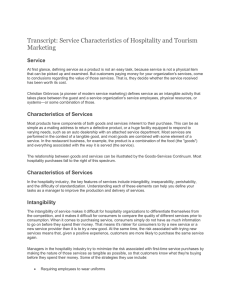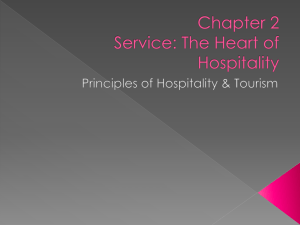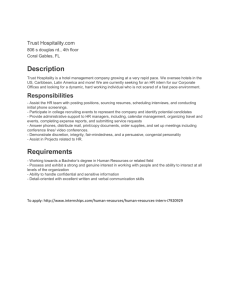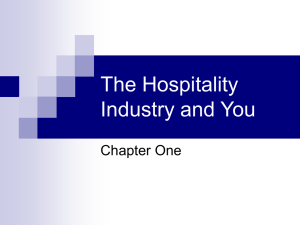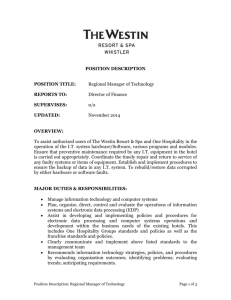Chapter 11: People: Services and Service Quality
advertisement
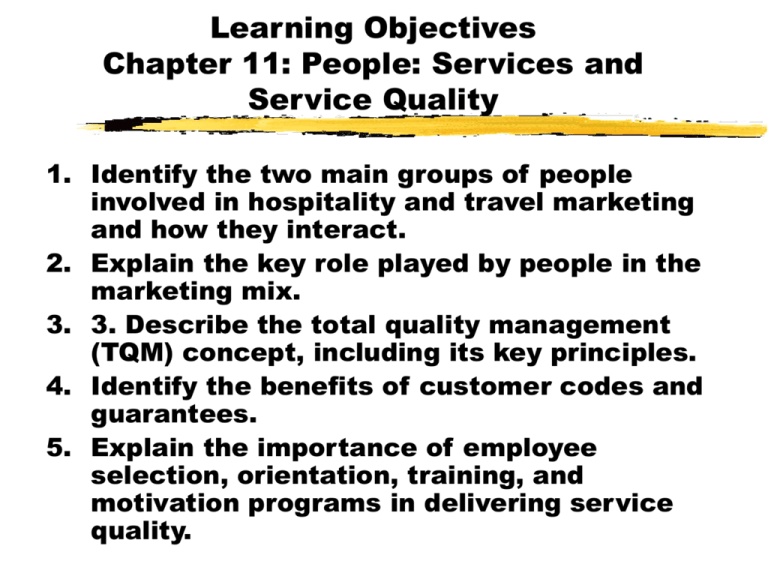
Learning Objectives Chapter 11: People: Services and Service Quality 1. Identify the two main groups of people involved in hospitality and travel marketing and how they interact. 2. Explain the key role played by people in the marketing mix. 3. 3. Describe the total quality management (TQM) concept, including its key principles. 4. Identify the benefits of customer codes and guarantees. 5. Explain the importance of employee selection, orientation, training, and motivation programs in delivering service quality. Learning Objectives Chapter 11: People: Services and Service Quality 6. Describe the concept of empowering employees and how important this is to customer satisfaction. 7. Explain the five dimensions of the SERVQUAL model and how this technique is used to measure service quality. 8. Explain why the relationship marketing concept is so important in the hospitality and travel industry and how it is done successfully. 9. Describe the customer mix and explain why organizations must manage it. Role Played by People in the Marketing Mix Personal service is the key component of the marketing mix in hospitality and travel. People alone can make or break a guest’s experience. No amount of good facilities can make up for poor service. Two Main Groups of People Involved in Hospitality and Tourism GUESTS (Customers) + HOSTS (Employees) Total Quality Management (TQM) A process designed to cut down on an organization’s “defects,” to determine its customer requirements, and to satisfy these requirements. TQM’s key principles are: 1. 2. 3. 4. 5. Commitment to quality Focus on customer satisfaction Assessment of organizational culture Empowerment of employees and teams Measurement of quality efforts TQM Benefits of Customer Codes and Guarantees Communicate to guests what to expect in the service delivery. Give the organization’s employees a clear idea of what is expected of them in serving guests. May also articulate what the organization will do for the guest if the service delivery is not satisfactory. Employee Selection, Orientation, Training, and Motivation Managing “internal customers” Staff selection Orientation Training Motivating and retaining Empowering Empowering Employees Giving employees the authority to identify and solve guest problems or complaints “on the spot,” and to make improvements in work processes when necessary Decentralizing decision-making or “flattening” the organization chart. Having greater trust in subordinates and their judgments SERVQUAL Model Dimensions 1. Tangibles (physical facilities, equipment, staff appearance). 2. Reliability (ability to perform the service dependably and accurately). 3. Responsiveness (willingness to help customers and to respond promptly). 4. Assurance (knowledge/courtesy of staff and ability to portray trust and confidence). 5. Empathy (degree of caring, individualized service). Relationship Marketing Building, maintaining, and enhancing long-term relationships with individual customers 1. Managing service encounters. 2. Providing customer incentives. 3. Providing special service options. 4. Developing pricing strategies to encourage long-term use. 5. Maintaining a customer database. 6. Communicating with customers through direct or specialized media. Customer Mix The customer mix is the combination of customers that use or are attracted to a specific hospitality and travel organization They must mix well and not conflict with one another


